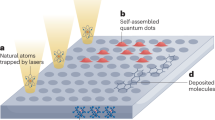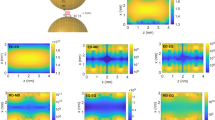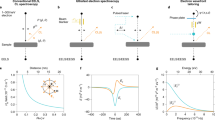Abstract
The vanishingly small response of matter to light above ultraviolet frequencies makes the manipulation of light emission at such frequencies challenging. As a result, state-of-the-art sources of high-frequency light are typically active, relying on strong external electromagnetic fields. Here, we present a fundamental mechanism of light emission that is fully passive, relying instead on vacuum fluctuations near nanophotonic structures. This mechanism can be used to generate light at any frequency, including high-frequency radiation such as X-rays. The proposed mechanism is equivalent to a quantum optical two-photon process, in which a free electron spontaneously emits a low-energy polariton and a high-energy photon simultaneously. Although two-photon processes are nominally weak, we find that the resulting X-ray radiation can be substantial. The strength of this process is related to the strong Casimir–Polder forces that atoms experience in the nanometre vicinity of materials, with the essential difference being that the fluctuating force here acts on a free electron, rather than a neutral, polarizable atom. The light emission can be shaped by controlling the nanophotonic geometry or the underlying material electromagnetic response at optical or infrared frequencies. Our results reveal ways of applying the tools of nanophotonics even at frequencies where materials have an insubstantial electromagnetic response. The process we study, when scaled up, may also enable new concepts for compact and tunable X-ray radiation.
This is a preview of subscription content, access via your institution
Access options
Access Nature and 54 other Nature Portfolio journals
Get Nature+, our best-value online-access subscription
$29.99 / 30 days
cancel any time
Subscribe to this journal
Receive 12 print issues and online access
$209.00 per year
only $17.42 per issue
Buy this article
- Purchase on Springer Link
- Instant access to full article PDF
Prices may be subject to local taxes which are calculated during checkout




Similar content being viewed by others
References
Dirac, P. A. The quantum theory of the emission and absorption of radiation. Proc. R. Soc. Lond. A 114, 243–265 (1927).
Lamb, W. E. Jr & Retherford, R. C. Fine structure of the hydrogen atom by a microwave method. Phys. Rev. 72, 241–243 (1947).
Lifshitz, E. The theory of molecular attractive forces between solids. Sov. Phys. JETP 2, 73–83 (1956).
Sandoghdar, V., Sukenik, C., Hinds, E. & Haroche, S. Direct measurement of the van der Waals interaction between an atom and its images in a micron-sized cavity. Phys. Rev. Lett. 68, 3432–3435 (1992).
Chan, H. B., Aksyuk, V. A., Kleiman, R. N., Bishop, D. J. & Capasso, F. Quantum mechanical actuation of microelectromechanical systems by the Casimir force. Science 291, 1941–1944 (2001).
Pendry, J. Shearing the vacuum-quantum friction. J. Phys. Condens. Matter 9, 10301–10320 (1997).
Johansson, J. R., Johansson, G., Wilson, C. & Nori, F. Dynamical Casimir effect in a superconducting coplanar waveguide. Phys. Rev. Lett. 103, 147003 (2009).
Nation, P., Johansson, J., Blencowe, M. & Nori, F. Colloquium: Stimulating uncertainty: amplifying the quantum vacuum with superconducting circuits. Rev. Mod. Phys. 84, 1–24 (2012).
Fulling, S. A. Nonuniqueness of canonical field quantization in Riemannian space-time. Phys. Rev. D 7, 2850–2862 (1973).
Davies, P. C. Scalar production in Schwarzschild and Rindler metrics. J. Phys. A 8, 609–616 (1975).
Unruh, W. G. Notes on black-hole evaporation. Phys. Rev. D 14, 870–892 (1976).
Joannopoulos, J. D., Johnson, S. G., Winn, J. N. & Meade, R. D. Photonic Crystals: Molding the Flow of Light (Princeton Univ. Press, 2011).
Basov, D., Fogler, M. & de Abajo, F. G. Polaritons in van der Waals materials. Science 354, aag1992 (2016).
Low, T. et al. Polaritons in layered two-dimensional materials. Nat. Mater. 16, 182–194 (2017).
Purcell, E. M. Spontaneous emission probabilities at radio frequencies. Phys. Rev. 69, 681 (1946).
Kleppner, D. Inhibited spontaneous emission. Phys. Rev. Lett. 47, 233–236 (1981).
Yablonovitch, E. Inhibited spontaneous emission in solid-state physics and electronics. Phys. Rev. Lett. 58, 2059–2062 (1987).
Luo, C., Ibanescu, M., Johnson, S. G. & Joannopoulos, J. Cerenkov radiation in photonic crystals. Science 299, 368–371 (2003).
De Abajo, F. G. Optical excitations in electron microscopy. Rev. Mod. Phys. 82, 209–275 (2010).
Sapienza, R. et al. Deep-subwavelength imaging of the modal dispersion of light. Nat. Mater. 11, 781–787 (2012).
Yang, Y. et al. Maximal spontaneous photon emission and energy loss from free electrons. Nat. Phys. 14, 894–899 (2018).
Rivera, N., Wong, L. J., Soljačić, M. & Kaminer, I. Ultrafast multiharmonic plasmon generation by optically dressed electrons. Phys. Rev. Lett. 122, 053901 (2019).
Pendry, J. Radiative exchange of heat between nanostructures. J. Phys. Condens. Matter 11, 6621–6633 (1999).
Volokitin, A. & Persson, B. N. Near-field radiative heat transfer and noncontact friction. Rev. Mod. Phys. 79, 1291–1329 (2007).
Reid, M. H., Rodriguez, A. W., White, J. & Johnson, S. G. Efficient computation of Casimir interactions between arbitrary 3D objects. Phys. Rev. Lett. 103, 040401 (2009).
Otey, C. R. et al. Thermal rectification through vacuum. Phys. Rev. Lett. 104, 154301 (2010).
Rodriguez, A. W., Capasso, F. & Johnson, S. G. The Casimir effect in microstructured geometries. Nat. Photon. 5, 211–221 (2011).
Shen, S., Narayanaswamy, A. & Chen, G. Surface phonon polaritons mediated energy transfer between nanoscale gaps. Nano Lett. 9, 2909–2913 (2009).
Rousseau, E. et al. Radiative heat transfer at the nanoscale. Nat. Photon. 3, 514–517 (2009).
Kim, K. et al. Radiative heat transfer in the extreme near field. Nature 528, 387–391 (2015).
Jackson, J. D. Classical Electrodynamics (Wiley, 1999).
Friedman, A., Gover, A., Kurizki, G., Ruschin, S. & Yariv, A. Spontaneous and stimulated emission from quasifree electrons. Rev. Mod. Phys. 60, 471–535 (1988).
Ginsburg, V. Applications of Electrodynamics in Theoretical Physics and Astrophysics (Routledge, 1989).
Pellegrini, C., Marinelli, A. & Reiche, S. The physics of X-ray free-electron lasers. Rev. Mod. Phys. 88, 015006 (2016).
Wong, L. J., Kaminer, I., Ilic, O., Joannopoulos, J. D. & Soljačić, M. Towards graphene plasmon-based free-electron infrared to X-ray sources. Nat. Photon. 10, 46–52 (2016).
Rosolen, G. et al. Metasurface-based multi-harmonic free-electron light source. Light Sci. Appl. 7, 64 (2018).
Feranchuk, I. & Ivashin, A. Theoretical investigation of the parametric X-ray features. J. Phys. 46, 1981–1986 (1985).
Jablan, M., Buljan, H. & Soljačić, M. Plasmonics in graphene at infrared frequencies. Phys. Rev. B 80, 245435 (2009).
Chen, J. et al. Optical nano-imaging of gate-tunable graphene plasmons. Nature 487, 77–81 (2012).
Fei, Z. et al. Gate-tuning of graphene plasmons revealed by infrared nano-imaging. Nature 487, 82–85 (2012).
Iranzo, D. A. et al. Probing the ultimate plasmon confinement limits with a van der Waals heterostructure. Science 360, 291–295 (2018).
Ni, G. et al. Fundamental limits to graphene plasmonics. Nature 557, 530–533 (2018).
Göppert-Mayer, M. Über elementarakte mit zwei quantensprüngen. Ann. Phys. 401, 273–294 (1931).
Cesar, C. L. et al. Two-photon spectroscopy of trapped atomic hydrogen. Phys. Rev. Lett. 77, 255–258 (1996).
Hayat, A., Ginzburg, P. & Orenstein, M. Observation of two-photon emission from semiconductors. Nat. Photon. 2, 238–241 (2008).
Nevet, A. et al. Plasmonic nanoantennas for broad-band enhancement of two-photon emission from semiconductors. Nano Lett. 10, 1848–1852 (2010).
Rivera, N., Kaminer, I., Zhen, B., Joannopoulos, J. D. & Soljačić, M. Shrinking light to allow forbidden transitions on the atomic scale. Science 353, 263–269 (2016).
Rivera, N., Rosolen, G., Joannopoulos, J. D., Kaminer, I. & Soljačić, M. Making two-photon processes dominate one-photon processes using mid-IR phonon polaritons. Proc. Natl. Acad. Sci. USA 114, 13607–13612 (2017).
Frank, I. Optics of light sources moving in refractive media. Science 131, 702–712 (1960).
Batygin, V. On the possibility of hard Vavilov–Cerenkov radiation. Sov. Phys. JETP 21, 179–180 (1965).
Batygin, V. & Kuz’menko, K. Quantum theory of Vavilov–Cerenkov radiation by an electron traveling in vacuum parallel to a dielectric surface. Sov. Phys. JETP 68, 437–440 (1975).
Goldstein, J. I. et al. Scanning Electron Microscopy and X-ray Microanalysis (Springer, 2017).
England, R. J. et al. Dielectric laser accelerators. Rev. Mod. Phys. 86, 1337–1389 (2014).
Blumenfeld, I. et al. Energy doubling of 42 GeV electrons in a metre-scale plasma wakefield accelerator. Nature 445, 741–744 (2007).
Boltasseva, A. & Shalaev, V. M. Transdimensional photonics. ACS Photon. 6, 1–3 (2019).
Naik, G. V. et al. Titanium nitride as a plasmonic material for visible and near-infrared wavelengths. Opt. Mater. Express 2, 478–489 (2012).
Rodriguez, A. W., Reid, M. H. & Johnson, S. G. Fluctuating-surface-current formulation of radiative heat transfer for arbitrary geometries. Phys. Rev. B 86, 220302 (2012).
Freund, I. & Levine, B. Parametric conversion of X-rays. Phys. Rev. Lett. 23, 854–857 (1969).
Eisenberger, P. & McCall, S. X-ray parametric conversion. Phys. Rev. Lett. 26, 684–688 (1971).
Glover, T. et al. X-ray and optical wave mixing. Nature 488, 603–608 (2012).
Rytov, S., Kravtsov, Y. A. & Tatarskii, V. Principles of Statistical Radiophysics. 3. Elements of Random Fields (Springer, 1989).
Scheel, S. & Buhmann, S. Macroscopic quantum electrodynamics-concepts and applications. Acta Phys. Slov. 58, 675–809 (2008).
Lifshitz, E. M. & Pitaevskii, L. P. Statistical Physics: Theory of the Condensed State Vol. 9 (Elsevier, 2013).
Acknowledgements
We thank T. Christensen and G. Rosolen for helpful discussions. This research was supported by the Binational USA-Israel Science Foundation (BSF). N.R. was supported by Department of Energy Fellowship DE-FG02-97ER25308. L.J.W. was supported by the Advanced Manufacturing and Engineering Young Individual Research Grant (no. A1984c0043) from the Science and Engineering Research Council of the Agency for Science, Technology and Research, Singapore. This work was also partly supported by the Army Research Office through the Institute for Soldier Nanotechnologies under contract no. W911NF-18-2-0048. This work was also supported in part by the MRSEC Program of the National Science Foundation under award number DMR – 1419807. I.K. was also supported by a Starter Grant from the European Research Council and by the Israel Science Foundation.
Author information
Authors and Affiliations
Contributions
N.R. led the work with substantial input from all other authors.
Corresponding authors
Ethics declarations
Competing interests
The authors declare no competing interests.
Additional information
Peer review information Nature Physics thanks Frank Koppens and Kimball Milton for their contribution to the peer review of this work.
Publisher’s note Springer Nature remains neutral with regard to jurisdictional claims in published maps and institutional affiliations.
Supplementary information
Supplementary Information
Supplementary Figs. 1–5, additional discussion and supplementary references.
Figure 2 data
Source data for Fig. 2.
Figure 3 data
Source data for Fig. 3.
Figure 4 data
Source data for Fig. 4.
Rights and permissions
About this article
Cite this article
Rivera, N., Wong, L.J., Joannopoulos, J.D. et al. Light emission based on nanophotonic vacuum forces. Nat. Phys. 15, 1284–1289 (2019). https://doi.org/10.1038/s41567-019-0672-8
Received:
Accepted:
Published:
Issue Date:
DOI: https://doi.org/10.1038/s41567-019-0672-8
This article is cited by
-
Quantum recoil in free-electron interactions with atomic lattices
Nature Photonics (2023)
-
Coherent interaction between free electrons and a photonic cavity
Nature (2020)
-
Casimir spring and dilution in macroscopic cavity optomechanics
Nature Physics (2020)
-
Light–matter interactions with photonic quasiparticles
Nature Reviews Physics (2020)
-
Tunable free-electron X-ray radiation from van der Waals materials
Nature Photonics (2020)



